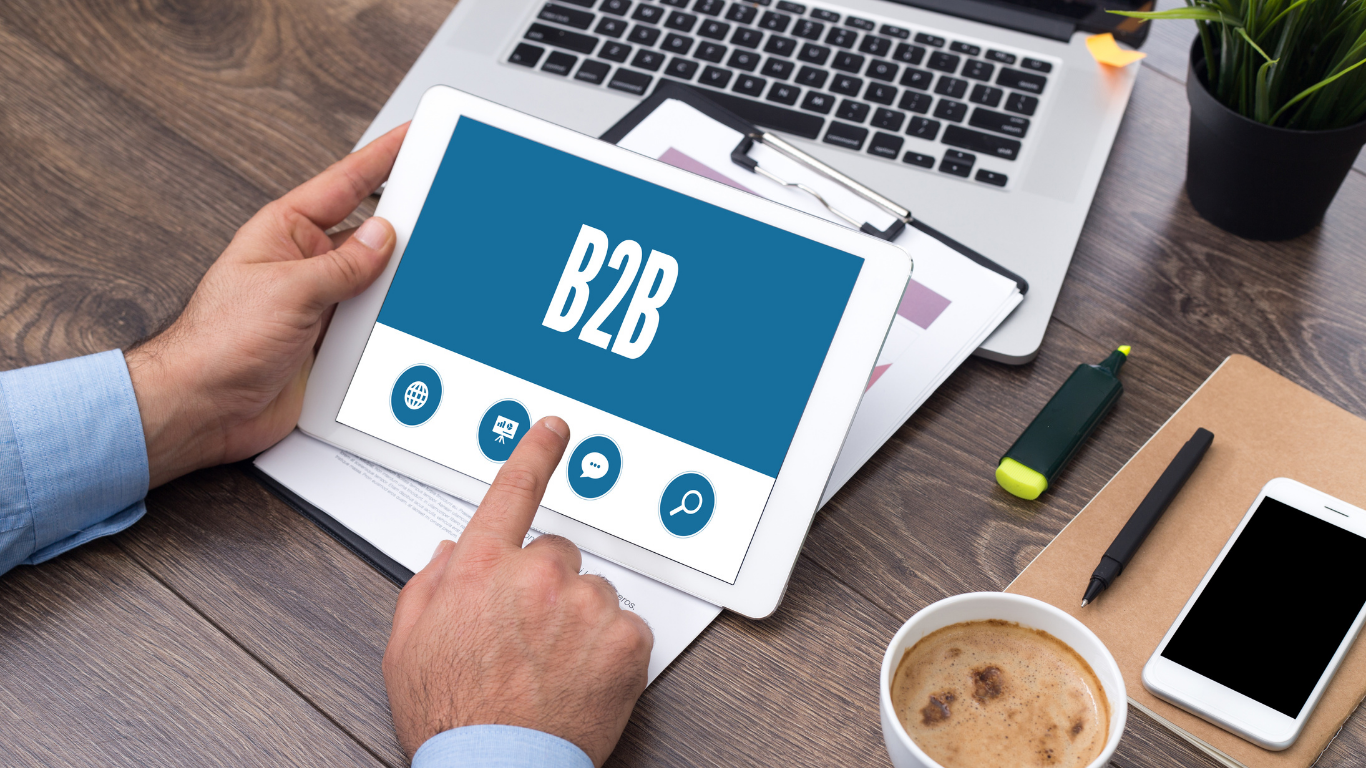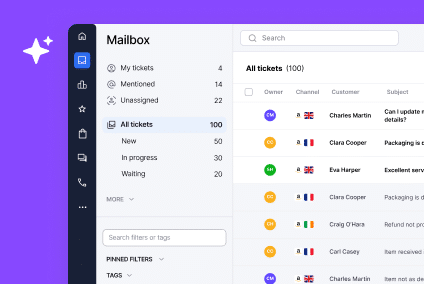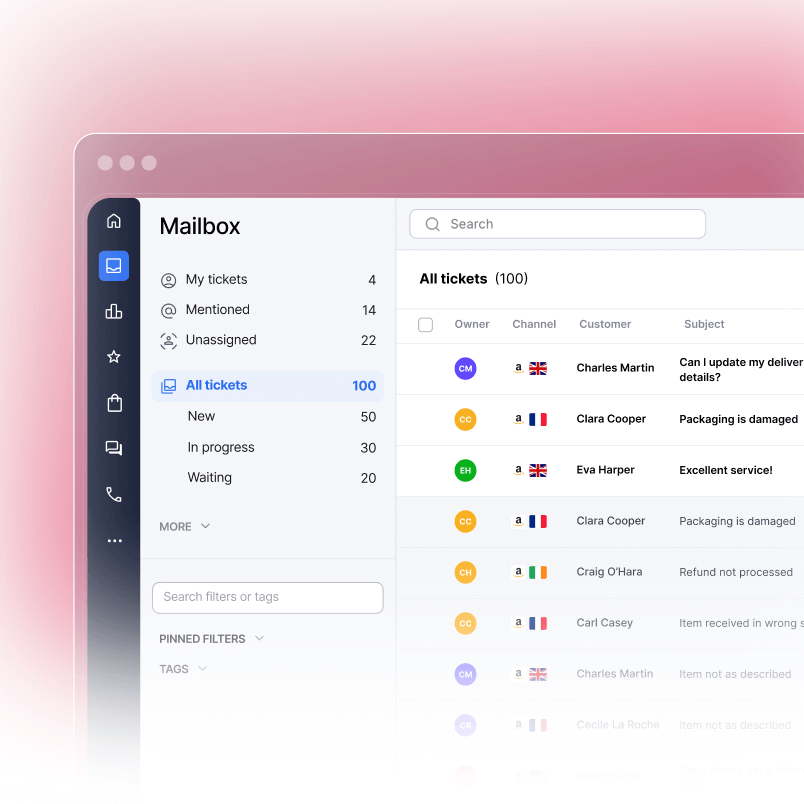B2B ecommerce customer service isn’t just B2C with bigger order numbers. The workflows are different. The buyers expect different things. The tools you need to support them aren’t the same. If you’re running a B2B ecommerce operation or evaluating platforms like Shopify Plus or BigCommerce B2B, understanding these differences determines whether your support team scales efficiently or burns out trying to force D2C playbooks into a B2B context. This guide breaks down what actually changes between B2B and D2C support, what tools work best for each model, and how to build workflows that your team can actually maintain.
What Is B2B Ecommerce and Why Support Differs
B2B ecommerce platforms are built for a fundamentally different transaction model than D2C stores. Instead of individual shoppers buying one item, you’re handling repeat account relationships with bulk orders, complex pricing, and ongoing business relationships.
Platforms like Shopify Plus, BigCommerce B2B, OroCommerce, and Adobe Commerce are designed for this. They support tiered pricing, purchase orders, quote requests, account-based portals, and multi-user team permissions. A single buyer organization might have 10 different people placing orders, but they all fall under one account with shared payment terms and credit limits. For a detailed comparison, see our guide on B2B ecommerce platforms and how they compare to standard D2C solutions.
According to Shopify’s research on B2B ecommerce trends, B2B online sales are growing faster than D2C, with businesses increasingly moving transactions online. This structure changes everything about support. One customer isn’t a one-time transaction. One customer is a revenue stream that needs to stay healthy. A single B2B account might generate more lifetime value than thousands of D2C customers.
How B2B Customer Service Differs from D2C
The differences between B2B and D2C support run across every dimension: who you serve, what they need, how they contact you, and what problems they face. Research on B2B customer service best practices shows that account management and dedicated support are top priorities for business buyers, whereas D2C customers prioritize fast response times and self-service options.
B2B Buyers Are Different
B2B buyers are repeat account holders with high transaction values. They buy regularly, place large orders, and expect continuity in their relationships. A D2C buyer is often a one-time or casual repeat shopper making individual purchases.
Order Complexity Changes Everything
B2B orders are typically large, complex, and recurring. A customer might order 500 units every month with custom invoice terms, partial shipments, and backorder arrangements. D2C orders are single-item, standardized, and low-ticket. A buyer orders a shirt in their size and expects it in two days.
Support Channels Differ
B2B support runs through email, phone, and dedicated account managers. Response times are tracked against service level agreements (SLAs). D2C support is available 24/7 through chat, social media, and helpdesks with immediate response expectations.
The Issues People Actually Need Help With
B2B support handles inventory checks, fulfillment status, invoice corrections, quote revisions, purchase order disputes, and bulk order modifications. D2C support handles shipping confirmations, returns, refunds, product questions, and order cancellations.
Key B2B Customer Service Requirements
Your B2B support team needs tools and workflows that D2C helpdesks simply weren’t built for.
Account-level support and permissions. Not every person at a customer’s company should see every order or account detail. You need role-based access controls. One buyer might only see their department’s orders. Finance might see invoices but not purchase history.
Dedicated representatives or account managers. B2B customers expect continuity. A dedicated rep should know their account history, their typical order size, their billing cycle, and their usual contacts. This builds trust and speeds up resolution.
SLA tracking and enforcement. B2B contracts often include response time commitments. Your system needs to track when tickets are opened, flag when SLAs are at risk, and show customers when their requests will be addressed. This isn’t optional. It’s contractual.
Quote generation and order revision workflows. Your customers need to request quotes, see pricing for different volumes, and modify orders before they’re final. D2C helpdesks don’t need this. B2B support systems must have it.
Backend integrations with your systems. Your support team needs real-time access to inventory levels, customer credit limits, previous orders, invoicing status, and fulfillment tracking. If they’re switching between three different systems to answer one question, you’re wasting time and money.
Why Generic D2C Support Tools Fall Short for B2B Operations
Most popular helpdesk software was built for D2C. Zendesk, for example, started with individual consumer support. These platforms can technically handle B2B cases, but they’re missing critical functionality.
No account management workflows. D2C tools treat each ticket as independent. B2B requires grouping tickets by account, managing team hierarchies at customer companies, and assigning reps to accounts rather than just tickets.
Poor visibility into quote and order history. A B2B customer’s support question often requires seeing five previous orders, understanding their typical volume, and knowing what quotes you’ve offered them before. D2C systems weren’t designed to surface this context.
Inadequate SLA handling. D2C tools might track response time, but they don’t intelligently route tickets to meet SLAs or escalate when time is running out. B2B contracts depend on this.
Limited integration with ERP and inventory systems. Your B2B customers need real answers about stock levels and fulfillment dates. If your support software can’t talk to your warehouse system or ERP, your team is giving outdated information or logging back into a separate system for each answer.
Best Ecommerce Support Platforms for B2B
Different platforms serve different needs. Here’s what actually works for B2B.
HubSpot Service Hub is CRM-native, meaning your customer data lives in one place. Account hierarchies are built in. You can assign reps to accounts, track communication history across email, chat, and calls, and integrate with your sales pipeline. It works well for B2B because support ties directly to account management. The downside is cost at scale.
Zoho Desk integrates with Zoho’s wider suite, including inventory management and CRM tools. If you’re already in the Zoho ecosystem, it’s seamless. Quote generation, customer portal access, and SLA tracking are all native features. If you’re not on Zoho, the learning curve is steeper.
Kustomer is built for high-touch, account-based workflows. It handles customer hierarchies, shared team inboxes, and custom SLA rules. It integrates with most ecommerce platforms and backend systems. It’s more expensive than basic helpdesks but is purpose-built for complex support operations. See our detailed breakdown of helpdesk options for businesses comparing support tools.
Shopify Plus and BigCommerce B2B have native support tooling built into their platforms. If your customers use Shopify Plus, you can leverage the native customer portal for account access, order history, and quote requests. BigCommerce B2B includes support for team permissions, purchase order workflows, and bulk ordering. For a head-to-head comparison of these platforms, review our BigCommerce vs Shopify guide. For businesses on these platforms, starting with native tools before adding a third-party helpdesk is worth testing.
Optimizing Support Workflows on B2B Platforms
Your B2B support operation should be built around the reality of bulk orders and account relationships. Industry leaders implementing SLA management best practices report faster resolution times and higher customer retention.
Segment your customers by account tier. Not every account deserves the same level of service. Set up SLA tiers: Tier 1 accounts (high revenue) get 2-hour response times. Tier 2 gets 4 hours. Tier 3 gets 24 hours. Route tickets accordingly.
Assign ticket routing by dedicated representative or region. Instead of round-robin ticket assignment, assign B2B customers to specific team members. This rep becomes the account expert. When they see an issue, context is already there.
Use shared inboxes with custom SLAs. Group customer emails into shared inboxes by account or region. Track response times for each SLA bucket separately. Know which accounts are waiting longest and which reps are handling the most complex issues.
Track resolution time by account and order type. Which accounts‘ issues take longest to resolve? Are inventory questions slower than invoice disputes? Are new accounts slower than established ones? Use this data to train your team and identify process gaps.
Integrate your support workflow with quoting and invoicing tools. When a customer asks about a quote, your rep shouldn’t manually search for it. Pull it directly from your quoting system into the support interface. When resolving an invoice dispute, access invoices directly. Every integration saves 5 minutes per ticket across hundreds of tickets. Explore our guide on customer service automation tips for more strategies to scale your team.
Final Thoughts
B2B ecommerce support isn’t a scaled version of D2C. It’s a different model that requires different thinking. Your buyers are businesses, not individuals. Their orders are complex and recurring. Their expectations are contractual. Your tools need to support account hierarchies, bulk workflows, and integrations that D2C helpdesks weren’t built for.
Start by understanding your actual customer base. Are they true B2B accounts with multi-user teams and recurring orders? Or are you running B2C with bigger order sizes? Choose tools that match your model, not the other way around. If you’re building support for a B2B platform like BigCommerce B2B or Shopify Plus, test native features first. They often include account management and order workflows that external helpdesks charge extra for.
The best B2B support operation is the one that makes account management scalable. Dedicated reps, clear SLAs, shared inboxes, and backend integrations turn support from a cost center into a retention tool. When your support team can resolve issues quickly because they have context and access, your customers stay longer and order more.
FAQs
What is the best customer support platform for B2B ecommerce?
There’s no single best platform. It depends on your existing tools, team size, and complexity. Kustomer works well for complex account-based operations. HubSpot Service Hub works if you want CRM integration. Zoho Desk works if you’re already in the Zoho ecosystem. BigCommerce B2B users should test native tools first before adding layers. Consider what your team already knows and what integrations matter most to your operation.
How does B2B support differ from D2C?
B2B serves repeat, high-value accounts with complex bulk orders and SLA commitments. D2C serves individual shoppers with standardized orders. B2B support teams need account management tools, quote workflows, backend integrations, and role-based access controls. D2C teams need fast chat, self-service returns, and 24/7 availability. Different buyers need different support models.
Can I use the same helpdesk for both B2B and D2C operations?
Technically yes, but it usually creates friction. If you’re running both models, segment your tickets clearly. Use different queues for B2B and D2C. Assign different SLAs. Give your B2B team access to account-level tools and your D2C team access to self-service features. If the majority of your business is D2C, a generic helpdesk works. If you have significant B2B revenue, invest in B2B-specific features or accept slower service.
What should I look for in a B2B ecommerce platform’s support features?
Look for account hierarchies with role-based access. Look for native quote and purchase order workflows. Look for SLA tracking and customer portal access. Check if it integrates with your ERP or inventory system. Verify that it handles partial shipments, backorders, and complex billing. Test the customer-facing portal to make sure buyers can check order status, request quotes, and download invoices without contacting support.
Does B2B customer service require dedicated account managers?
For high-value accounts, yes. Dedicated account managers build relationships, understand customer needs, and solve problems before they escalate. For mid-market accounts, shared account management by region or industry works. For smaller accounts, ticket-based support is fine. Your SLA tier should determine this.




